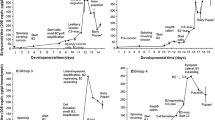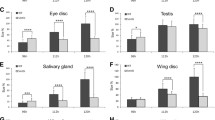Summary
This paper describes two ecdysone-deficient, recessive-lethal mutants,lethal(1)giant ring gland (grg) andlethal(1)suppressor of forked mad-ts (mad-ts: Jürgens and Gateff 1979) and compares their ecdysteroid titers with that of the wild-type. Mutant larvae show a much reduced ecdysteroid content, amounting to 1/10 to 1/30 of the wild-type values, but never a true titer peak. They fail to pupate and die after 1–3 weeks. Ecdysteroid feeding elicits different responses in the larvae of the two mutants.mad-ts larvae pupate within 24 h, thus showing that their low ecdysteroid titer is directly connected to their inability to pupate.mad-ts resembles the mutantlethal (3)ecdysone-1 ts (Garen et al. 1977). Thegrg mutant larvae, on the other hand, fail to pupate after 20-hydroxyecdysone feeding as well as injection. The primary defect of thegrg mutant is not entirely clear. Thegrg larval salivary gland cells appear to possess normal ecdysteroid receptors. Furthermore, the low ecdysteroid titer ingrg is not the result of an increased ecdysteroid catabolism. The primary defect in the mutant may lie in the malfunctioning neurosecretory cells which do not show neurosecretion in histological preparations. Further support for this notion comes from electronmicrographs of the enlargedgrg ring glands which, in contrast to the wild-type, do not possess nerve endings.
In the wild-type three ecdysteroid peaks were found: one shortly before puparium formation, the second at approximately 12 h and the third at about 30 h after pupation. The ecdysteroid titer peak in late third instar, wild-type larvae is mainly due to the presence of 20-dydroxyecdysone as shown by radioimmunoassays after thin layer chromatography and derivatization followed by gas liquid chromatography and mass spectroscopy. In addition, a number of unidentified polar and apolar metabolites were also present.
Similar content being viewed by others
References
Aggarwal SK, King RE (1969) A comparative study of the ring gland from wild-type and1(2)gl mutantDrosophila melanogaster. J Morphol 123:171–199
Ashburner M, Richards G (1976) Sequential gene activation by ecdysone in polytene chromosomes ofDrosophila melanogaster. III. Consequences of ecdysone withdrawal. Dev Biol 54:241–255
Beckers C (1977) Untersuchungen zum Titer und Metabolismus des Häutungshormones inDrosophila hydei und seine Bindung in den Zielorganen. Ph. D. Thesis, Technische Hochschule, Darmstadt
Borst DW, Bollenbacher WE, O'Connor JD, King DS, Fristrom JW (1974) Ecdysone levels during metamorphosis ofDrosophila melanogaster. Dev Biol 39:308–316
Borst DW, O'Conner JD (1974) Trace analysis of ecdysone by gas liquid chromatography, radioimmunoassay and bioassay. Steroids 24:637–656
Davies P, Allison AC (1976) The secretion of lysosomal enzymes. In: Dingle JT, Dean, RT (eds) Lysosomes in biology and pathology Vol 5. North Holland, Amsterdam, pp 61–98
Delbecque JP, Hirn M, Delachambre J, DeReggi M (1978) Cuticular cycle and molting hormone levels during the metamorphosis ofTenebrio molitor (Insecta Coleoptera). Dev Biol 64:11–30
DeReggi M, Hirn MH, DeLaage JM (1975) Radioimmunoassay of ecdysone An application toDrosophila larvae and pupae. Biochem Biophys Res Commun 66:1307–1312
Franke WW, Krien S, Brown RM Jr (1969) Simultaneous glutaral-dehyde osmium tetroxyde fixation with postosmication. An improved fixation procedure for electron microscopy of plant and animal cells. Histochem 19:162–164
Garen A, Kauvar L, Lepesant JA (1977) Roles of ecdysone inDrosophila development. Proc Natl Acad Sci USA 74:5099–5103
Gateff E (1978) The genetics and epigenetics of neoplasms inDrosophila. Biol Rev 53:123–168
Hodgetts RB, Sage B, O'Connor JD (1977) Ecdysone titers during postembryonic development ofDrosophila melanogaster. Dev Biol 60:310–317
Holden J, Asburner M (1978) Patterns of puffing activity in the salivary gland chromosomes of Drosophila: IX. The salivary and prothoracic gland chromosomes of a dominant, temperature-sensitive lethal ofDrosophila melanogaster. Chromosoma 68:205–227
Ikekawa N, Natori F, Lubio-Lightbourn J (1972) The chromatographic separation of phytoecdysones. J Chromatogr Sci 10:233–242
Jürgens G, Gateff E (1979) Pattern specification in imaginal discs ofDrosophila: Developmental analysis of a temperature-sensitive mutant producing duplicated legs. Wilhelm Roux's Archives 186:1–25
Kiss I, Bencze G, Fekete E, Fodor A, Gausz J, Marby P, Szabad J, Szidonya J (1976) Isolation and characterization of X-linked lethal mutants affecting differentiation of the imaginal disc inDrosophila melanogaster. Theor Appl Genet 48:217–226
Kiss I, Szabad J, Major J (1978) Genetic and developmental analysis of puparium formation inDrosophila. Molec Gen Genet 164:77–83
Lefevre G Jr (1976) A photographic representation and interpretation of the polytene chromosomes ofDrosophila melanogaster salivary glands. In: (Ashburner M, Novitski E (eds) The genetics and biology ofDrosophila, Vol 1a. pp 31–64
Lindsley DL, Grell EH (1968) Genetic variations ofDrosophila melanogaster. Carnegie Inst Washington Publ No 627
Miyazaki H, Ishibashi M, Mori C, Ikekawa N (1973) Gas phase microanalysis of zooecdysones. Anal Chem 45:1164–1168
Mollet P, Würgler FE (1973) An apparatus to inject large numbers ofDrosophila with constant amounts of fluid within a short time. Dros Inform Serv 50:220
Morgan ED, Poole CF (1976a) The formation of trimethylsilyl ethers of ecdysone: A reapparaisal. J Chromatogr 116:333–341
Morgan ED, Poole CF (1976b) The extraction and determination of ecdysones in arthropods. Adv Insect Physiol 12:17–62
Morgan ED, Poole CF (1976c) The pattern of ecdysone levels during development of the desert locust,Schistocerca gregaria. J Insect Physiol 22:885–889
Rayle RE (1967) A new mutant inDrosophila melanogaster causing an ecdysone curable interruption of the prepupal molt. Genetics 56:583
Russell ES (1940) A comparison of benign and ‘malignant’ tumors inDrosophila melanogaster. J Exp Zool 84:363–386
Shields G, Dübendorfer A, Sang JH (1975) Differentiation in vitro of larval cell-types from embryonic cells ofDrosophila melanogaster. J Embryol Exp Morphol 33:159–175
Spindler K-D, Beckers C, Gröschel-Stewart U, Emmerich H (1978) A radioimmunoassay for arthropod moulting hormones, introducing novel method of immunogen coupling. Hoppe-Seyler's Z Physiol Chem 359:1269–1275
Author information
Authors and Affiliations
Rights and permissions
About this article
Cite this article
Klose, W., Gateff, E., Emmerich, H. et al. Developmental studies on two ecdysone deficient mutants ofDrosophila melanogaster . Wilhelm Roux' Archiv 189, 57–67 (1980). https://doi.org/10.1007/BF00848567
Received:
Accepted:
Issue Date:
DOI: https://doi.org/10.1007/BF00848567




